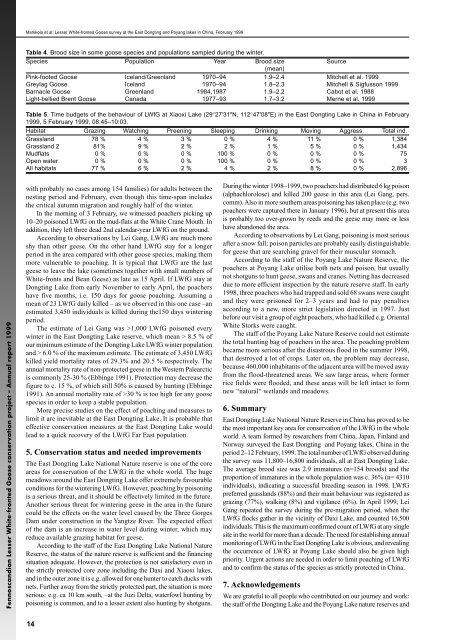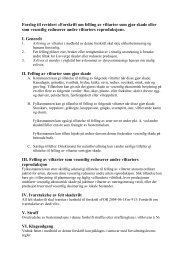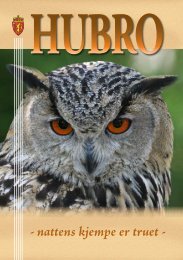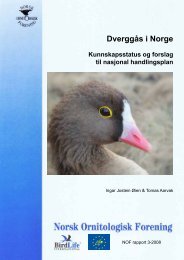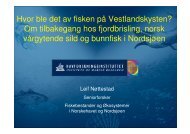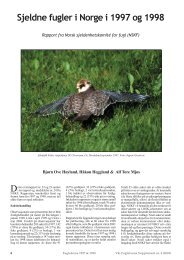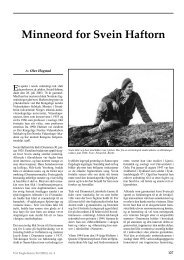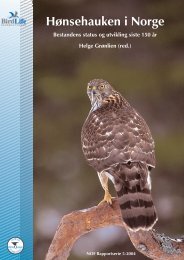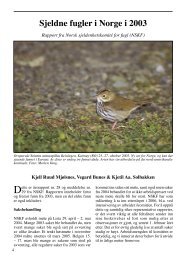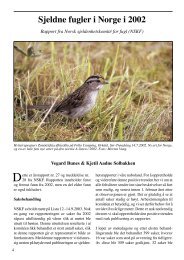Fennoscandian Lesser White-fronted Goose conservation project ...
Fennoscandian Lesser White-fronted Goose conservation project ...
Fennoscandian Lesser White-fronted Goose conservation project ...
You also want an ePaper? Increase the reach of your titles
YUMPU automatically turns print PDFs into web optimized ePapers that Google loves.
<strong>Fennoscandian</strong> <strong>Lesser</strong> <strong>White</strong>-<strong>fronted</strong> <strong>Goose</strong> <strong>conservation</strong> <strong>project</strong> – Annual report 1999<br />
Markkola et al: <strong>Lesser</strong> <strong>White</strong>-<strong>fronted</strong> <strong>Goose</strong> survey at the East Dongting and Poyang lakes in China, February 1999<br />
Table 4. Brood size in some goose species and populations sampled during the winter.<br />
Species Population Year Brood size Source<br />
(mean)<br />
Pink-footed <strong>Goose</strong> Iceland/Greenland 1970–94 1.9–2.4 Mitchell et al. 1999<br />
Greylag <strong>Goose</strong> Iceland 1970–94 1.8–2.3 Mitchell & Sigfusson 1999<br />
Barnacle <strong>Goose</strong> Greenland 1984,1987 1.9–2.2 Cabot et al. 1988<br />
Light-bellied Brent <strong>Goose</strong> Canada 1977–93 1.7–3.2 Merne et al. 1999<br />
Table 5. Time budgets of the behaviour of LWfG at Xiaoxi Lake (29°27'31"N, 112°47'08"E) in the East Dongting Lake in China in February<br />
1999, 5 February 1999, 08:45–10:03.<br />
Habitat Grazing Watching Preening Sleeping Drinking Moving Aggress. Total ind.<br />
Grassland 78 % 4 % 3 % 0 % 4 % 11 % 0 % 1,384<br />
Grassland 2 81% 9 % 2 % 2 % 1 % 5 % 0 % 1,434<br />
Mudflats 0 % 0 % 0 % 100 % 0 % 0 % 0 % 75<br />
Open water 0 % 0 % 0 % 100 % 0 % 0 % 0 % 3<br />
All habitats 77 % 6 % 2 % 4 % 2 % 8 % 0 % 2,896<br />
with probably no cases among 154 families) for adults between the<br />
nesting period and February, even though this time-span includes<br />
the critical autumn migration and roughly half of the winter.<br />
In the morning of 3 February, we witnessed poachers picking up<br />
10–20 poisoned LWfG on the mud-flats at the <strong>White</strong> Crane Mouth. In<br />
addition, they left three dead 2nd calendar-year LWfG on the ground.<br />
According to observations by Lei Gang, LWfG are much more<br />
shy than other geese. On the other hand LWfG stay for a longer<br />
period in the area compared with other goose species, making them<br />
more vulnerable to poaching. It is typical that LWfG are the last<br />
geese to leave the lake (sometimes together with small numbers of<br />
<strong>White</strong>-fronts and Bean Geese) as late as 15 April. If LWfG stay at<br />
Dongting Lake from early November to early April, the poachers<br />
have five months, i.e. 150 days for goose poaching. Assuming a<br />
mean of 23 LWfG daily killed – as we observed in this one case –an<br />
estimated 3,450 individuals is killed during the150 days wintering<br />
period.<br />
The estimate of Lei Gang was >1,000 LWfG poisoned every<br />
winter in the East Dongting Lake reserve, which mean > 8.5 % of<br />
our minimum estimate of the Dongting Lake LWfG winter population<br />
and > 6.0 % of the maximum estimate. The estimate of 3,450 LWfG<br />
killed yield mortality rates of 29.3% and 20.5 % respectively. The<br />
annual mortality rate of non-protected geese in the Western Palearctic<br />
is commonly 25-30 % (Ebbinge 1991). Protection may decrease the<br />
figure to c. 15 %, of which still 50% is caused by hunting (Ebbinge<br />
1991). An annual mortality rate of >30 % is too high for any goose<br />
species in order to keep a stable population.<br />
More precise studies on the effect of poaching and measures to<br />
limit it are inevitable at the East Dongting Lake. It is probable that<br />
effective <strong>conservation</strong> measures at the East Dongting Lake would<br />
lead to a quick recovery of the LWfG Far East population.<br />
5. Conservation status and needed improvements<br />
The East Dongting Lake National Nature reserve is one of the core<br />
areas for <strong>conservation</strong> of the LWfG in the whole world. The huge<br />
meadows around the East Dongting Lake offer extremely favourable<br />
conditions for the wintering LWfG. However, poaching by poisoning<br />
is a serious threat, and it should be effectively limited in the future.<br />
Another serious threat for wintering geese in the area in the future<br />
could be the effects on the water level caused by the Three Gorges<br />
Dam under construction in the Yangtze River. The expected effect<br />
of the dam is an increase in water level during winter, which may<br />
reduce available grazing habitat for geese.<br />
According to the staff of the East Dongting Lake National Nature<br />
Reserve, the status of the nature reserve is sufficient and the financing<br />
situation adequate. However, the protection is not satisfactory even in<br />
the strictly protected core zone including the Daxi and Xiaoxi lakes,<br />
and in the outer zone it is e.g. allowed for one hunter to catch ducks with<br />
nets. Further away from the strictly protected part, the situation is more<br />
serious: e.g. ca 10 km south, –at the Juzi Delta, waterfowl hunting by<br />
poisoning is common, and to a lesser extent also hunting by shotguns.<br />
14<br />
During the winter 1998–1999, two poachers had distributed 6 kg poison<br />
(alphachlorolose) and killed 200 geese in this area (Lei Gang, pers.<br />
comm). Also in more southern areas poisoning has taken place (e.g. two<br />
poachers were captured there in January 1996), but at present this area<br />
is probably too over-grown by reeds and the geese may more or less<br />
have abandoned the area.<br />
According to observations by Lei Gang, poisoning is most serious<br />
after a snow fall; poison particles are probably easily distinguishable<br />
for geese that are searching gravel for their muscular stomach.<br />
According to the staff of the Poyang Lake Nature Reserve, the<br />
poachers at Poyang Lake utilise both nets and poison, but usually<br />
not shotguns to hunt geese, swans and cranes. Netting has decreased<br />
due to more efficient inspection by the nature reserve staff. In early<br />
1998, three poachers who had trapped and sold 68 swans were caught<br />
and they were prisoned for 2–3 years and had to pay penalties<br />
according to a new, more strict legislation directed in 1997. Just<br />
before our visit a group of eight poachers, who had killed e.g. Oriental<br />
<strong>White</strong> Storks were caught.<br />
The staff of the Poyang Lake Nature Reserve could not estimate<br />
the total hunting bag of poachers in the area. The poaching problem<br />
became more serious after the disastrous flood in the summer 1998,<br />
that destroyed a lot of crops. Later on, the problem may decrease,<br />
because 460,000 inhabitants of the adjacent area will be moved away<br />
from the flood-threatened areas. We saw large areas, where former<br />
rice fields were flooded, and these areas will be left intact to form<br />
new “natural“ wetlands and meadows.<br />
6. Summary<br />
East Dongting Lake National Nature Reserve in China has proved to be<br />
the most important key area for <strong>conservation</strong> of the LWfG in the whole<br />
world. A team formed by researchers from China, Japan, Finland and<br />
Norway surveyed the East Dongting and Poyang lakes, China in the<br />
period 2–12 February, 1999. The total number of LWfG observed during<br />
the survey was 11,800–16,800 individuals, all at East Dongting Lake.<br />
The average brood size was 2.9 immatures (n=154 broods) and the<br />
proportion of immatures in the whole population was c. 36% (n= 4310<br />
individuals), indicating a successful breeding season in 1998. LWfG<br />
preferred grasslands (88%) and their main behaviour was registered as<br />
grazing (77%), walking (8%) and vigilance (6%). In April 1999, Lei<br />
Gang repeated the survey during the pre-migration period, when the<br />
LWfG flocks gather in the vicinity of Daxi Lake, and counted 16,500<br />
individuals. This is the maximum confirmed count of LWfG at any single<br />
site in the world for more than a decade. The need for establishing annual<br />
monitoring of LWfG in the East Dongting Lake is obvious, and revealing<br />
the occurrence of LWfG at Poyang Lake should also be given high<br />
priority. Urgent actions are needed in order to limit poaching of LWfG<br />
and to confirm the status of the species as strictly protected in China.<br />
7. Acknowledgements<br />
We are grateful to all people who contributed on our journey and work:<br />
the staff of the Dongting Lake and the Poyang Lake nature reserves and


